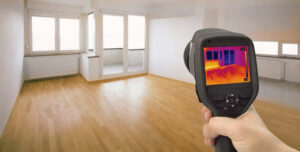This post which follows pertaining to Detecting hidden plumbing leaks is without a doubt intriguing. You should check it out.

Early detection of leaking water lines can minimize a potential catastrophe. Some little water leaks may not be noticeable.
1. Analyze the Water Meter
Every house has a water meter. Checking it is a proven manner in which aids you uncover leaks. For beginners, shut off all the water sources. Ensure no one will certainly flush, make use of the faucet, shower, run the washing machine or dishwashing machine. From there, go to the meter and also watch if it will alter. Since nobody is using it, there ought to be no motions. That shows a fast-moving leak if it relocates. If you find no modifications, wait an hour or two as well as inspect back once more. This implies you may have a slow leakage that might even be below ground.
2. Check Water Consumption
If you spot unexpected changes, despite your intake being the very same, it suggests that you have leaks in your plumbing system. An abrupt spike in your bill indicates a fast-moving leakage.
At the same time, a consistent increase each month, despite having the same behaviors, reveals you have a slow-moving leak that's likewise gradually escalating. Call a plumber to extensively examine your residential or commercial property, specifically if you feel a cozy area on your flooring with piping beneath.
3. Do a Food Coloring Test
When it comes to water usage, 30% comes from commodes. If the color somehow infiltrates your bowl throughout that time without flushing, there's a leak between the storage tank and dish.
4. Asses Exterior Lines
Do not fail to remember to examine your exterior water lines too. Test spigots by connecting a yard hose. Needs to water leak out of the connection, you have a loose rubber gasket. Change this and ensure all links are limited. If you've obtained a lawn sprinkler, it will assist get it skillfully took a look at and preserved every year. One small leakage can throw away lots of water as well as spike your water bill.
5. Evaluate as well as Analyze the Situation
Property owners need to make it a routine to inspect under the sink counters and even inside closets for any kind of bad odor or mold and mildew development. These 2 red flags suggest a leakage so punctual attention is required. Doing regular inspections, also bi-annually, can conserve you from a major trouble.
Inspect for discolorations and weakening as most pipes and also appliances have a life expectations. If you think dripping water lines in your plumbing system, do not wait for it to escalate.
Early discovery of leaking water lines can mitigate a prospective calamity. Some little water leaks might not be visible. Examining it is a proven means that assists you find leakages. One little leak can waste lots of water as well as spike your water costs.
If you suspect dripping water lines in your plumbing system, do not wait for it to rise.
WARNING SIGNS OF WATER LEAKAGE BEHIND THE WALL
PERSISTENT MUSTY ODORS
As water slowly drips from a leaky pipe inside the wall, flooring and sheetrock stay damp and develop an odor similar to wet cardboard. It generates a musty smell that can help you find hidden leaks.
MOLD IN UNUSUAL AREAS
Mold usually grows in wet areas like kitchens, baths and laundry rooms. If you spot the stuff on walls or baseboards in other rooms of the house, it’s a good indicator of undetected water leaks.
STAINS THAT GROW
When mold thrives around a leaky pipe, it sometimes takes hold on the inside surface of the affected wall. A growing stain on otherwise clean sheetrock is often your sign of a hidden plumbing problem.
PEELING OR BUBBLING WALLPAPER / PAINT
This clue is easy to miss in rooms that don’t get much use. When you see wallpaper separating along seams or paint bubbling or flaking off the wall, blame sheetrock that stays wet because of an undetected leak.
BUCKLED CEILINGS AND STAINED FLOORS
If ceilings or floors in bathrooms, kitchens or laundry areas develop structural problems, don’t rule out constant damp inside the walls. Wet sheetrock can affect adjacent framing, flooring and ceilings.
https://www.servicemasterbyzaba.com/blog/how-to-detect-water-leakage-in-walls/

Do you appreciate more info about Leaking water lines? Write feedback below. We would be pleased to know your insights about this blog posting. We hope that you come back again soon. Those who appreciated our blog post kindly don't forget to share it. Many thanks for your time spent reading it.